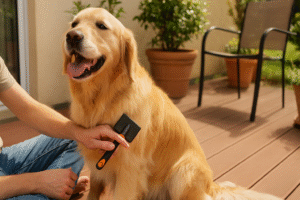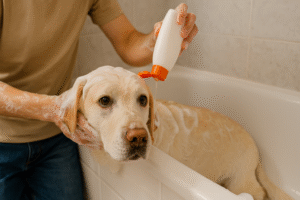What is Pet Grooming at Home?
Pet grooming at home means taking care of your dog or cat’s hygiene without always relying on professional groomers. It includes bathing, brushing, nail trimming, ear cleaning, and dental care.
Unlike professional services, at-home grooming happens in a familiar environment, which can reduce stress for pets—especially anxious dogs or cats. In 2025, more pet owners are choosing home grooming thanks to cost savings, convenience, and better bonding.

Benefits of Grooming Your Pet at Home
Health Benefits
Regular grooming helps detect skin problems, fleas, ticks, ear infections, or lumps early. Brushing distributes natural oils and prevents mats that cause discomfort.
Bonding Benefits
When you handle your pet gently during grooming, it builds trust and strengthens your bond. Pets learn to associate care with love, not stress.
Cost Savings
Professional grooming can cost $50–$100+ per session. Home grooming tools are a one-time investment that quickly pays off.
Stress Reduction for Anxious Pets
Some pets dislike new environments. Grooming at home offers familiar smells, calm surroundings, and less fear.
How to Groom Your Pet at Home: Step-by-Step
Preparing Your Grooming Space
Choose a quiet, well-lit space with a non-slip mat. Gather tools before starting to avoid interruptions.
Bathing Your Pet
-
Use lukewarm water.
-
Select a pet-safe shampoo (avoid human shampoos).
-
Massage gently into the coat, rinse thoroughly.
-
Frequency: Dogs (every 4–6 weeks, depending on coat). Cats usually need fewer baths unless dirty.
👉 Read more: How Often Should You Bathe a Dog?

Brushing and Detangling Fur
-
Short coats → rubber curry brush.
-
Long coats → slicker brush and comb.
-
Brush in sections to remove tangles and prevent mats.
👉 Best Brushes for Long-Haired Dogs
Nail Trimming Safely
-
Use pet clippers or a nail grinder.
-
Trim just below the curve—avoid the quick (pink part inside nail).
-
Reward with treats.
Ear Cleaning
-
Use vet-approved ear cleaner.
-
Gently wipe inside with a cotton pad (never push deep).
Dental Hygiene
-
Brush teeth with a pet toothbrush and pet-safe toothpaste.
-
Supplement with dental chews.
Drying and Finishing Touches
-
Towel dry thoroughly.
-
Use a pet dryer on low setting if needed.
-
Finish with a brush to smooth the coat.
Common Mistakes in Home Grooming (and How to Avoid Them)
Bathing Too Often or Too Rarely
Frequent baths strip oils, while too few baths cause odor and buildup. Follow breed-specific guidelines.
Using Human Shampoo
Human products disrupt a pet’s skin pH and may cause irritation. Always use dog or cat shampoos.
Cutting Nails Too Short
Hitting the quick can cause pain and bleeding. Trim gradually or use grinders for precision.
Ignoring Ears, Teeth, or Paws
These are high-risk areas for infections. Include them in every grooming session.
Skipping Brushing for Long-Haired Breeds
Mats lead to painful skin conditions. Brush regularly, especially for breeds like Huskies or Persians.
Best Grooming Tools and Products for Home Use
Brushes & Combs
-
Slicker brushes for tangles.
-
Undercoat rakes for double-coated dogs.
-
Rubber brushes for short-haired pets.
Shampoos for Sensitive Skin
-
Hypoallergenic formulas.
-
Oatmeal-based shampoos for itching.
👉 Best Dog Shampoos for Sensitive Skin
Clippers, Scissors, and Nail Grinders
-
Quiet clippers reduce anxiety.
-
Round-tip scissors for trimming around face/paws.
Ear Cleaners & Dental Kits
-
Vet-approved ear cleaning solutions.
-
Toothbrush + enzymatic toothpaste.
Drying Tools
-
Microfiber towels for quick drying.
-
Pet dryers with low-noise features.
Expert Tips & Recommendations
Make Grooming a Positive Experience
Use positive reinforcement—treats, calm voice, short sessions.
Grooming Schedules by Breed
-
Short-haired dogs: brush weekly.
-
Long-haired dogs: brush daily.
-
Cats: brush 2–3 times per week depending on coat length.
When to See a Professional Groomer
-
Severe matting.
-
Breed-specific cuts (Poodles, Shih Tzus).
-
Medical concerns requiring special care.
Handling Anxious Pets
Start slowly. Desensitize your pet by introducing tools gradually. Offer breaks and rewards.
FAQs About Grooming Pets at Home
How often should I bathe my dog or cat?
Dogs: every 4–6 weeks (unless muddy). Cats: rarely, unless dirty or hairless breeds.
What’s the safest way to trim my pet’s nails?
Use sharp clippers or a grinder. Trim gradually, avoiding the quick.
Can I use baby shampoo on my pet?
No. Baby shampoo isn’t pH-balanced for pets and may cause skin irritation.
How do I know if I’m brushing correctly?
You should remove loose fur without pulling. The brush should glide smoothly.
Is professional grooming still necessary sometimes?
Yes—for specific breeds, advanced cuts, or medical skin/coat conditions.
Conclusion
Grooming your pet at home is more than just keeping them clean—it’s about health, comfort, and bonding. With the right tools, patience, and routine, you can keep your dog or cat looking and feeling their best.
Start small: brushing a few times a week or trimming nails once a month. With time, both you and your pet will enjoy the grooming process.
👉 Explore more guides on PetWiseTips.com to make pet care simple and stress-free.
